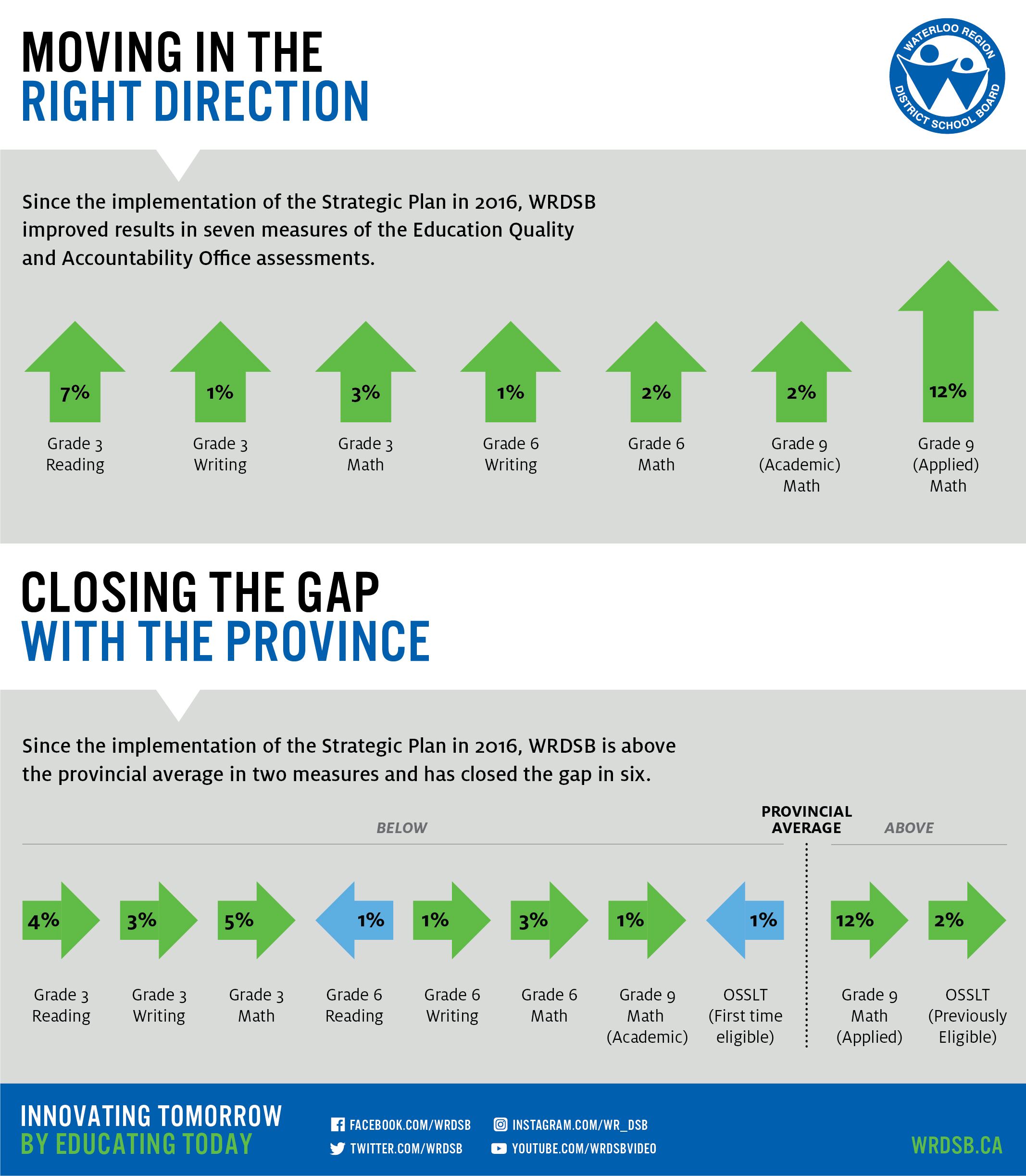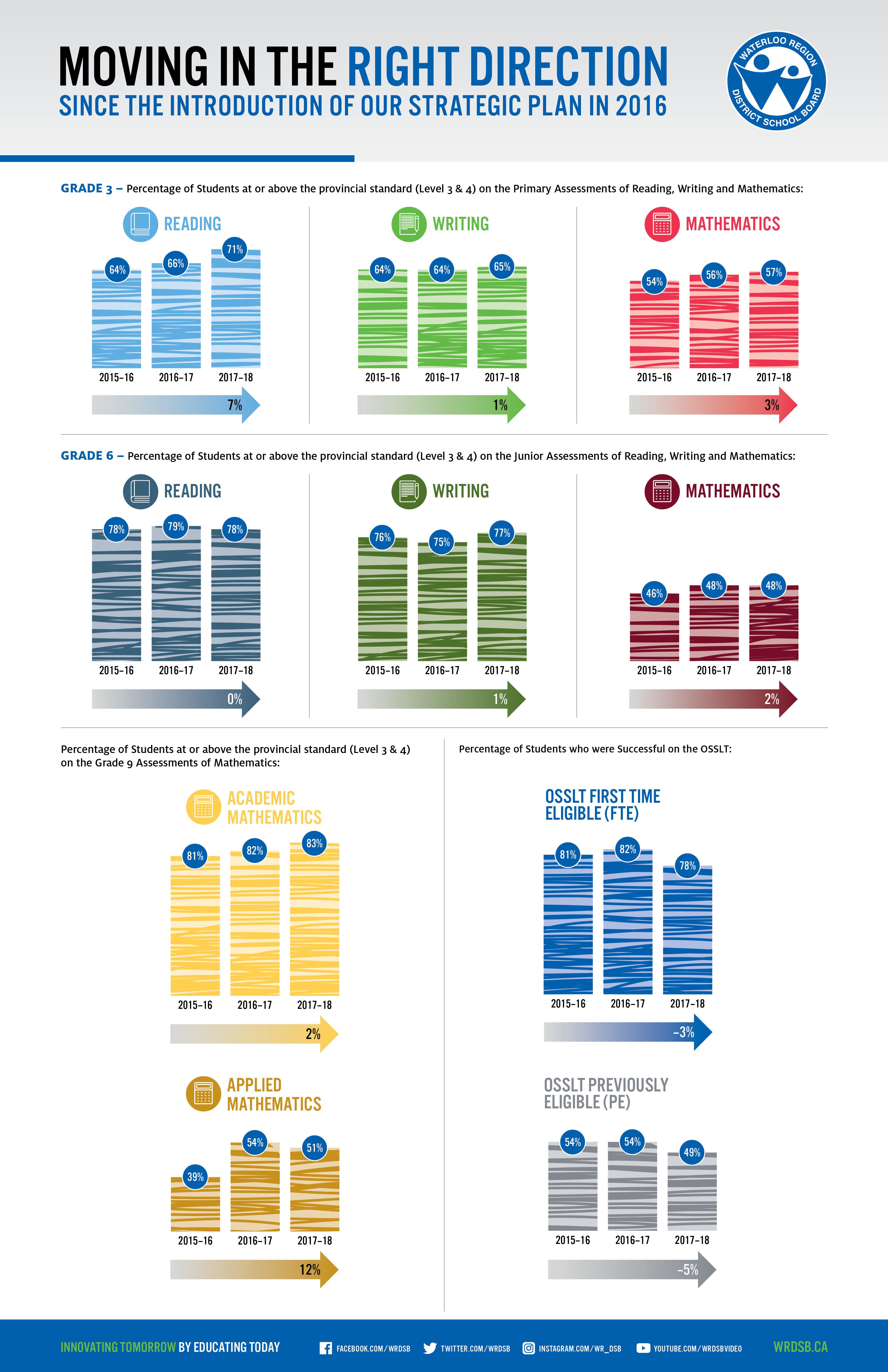September 19th, 2018
Waterloo Region District School Board (WRDSB) results in standardized tests for reading, writing and mathematics continued to make progress towards the provincial average in results released today by the Education Quality and Accountability Office (EQAO).
WRDSB continues to be above the provincial average in Grade 9 applied mathematics. This year results for previously-eligible students for the Ontario Secondary School Literacy Test (OSSLT) also remained above the provincial average.
“Two years ago we set ambitious goals for improving outcomes in the areas of mathematics, graduation rates and well-being across our district,” said John Bryant, director of education. “Since then, staff have worked diligently engaging students in their learning and the results released today by the Education Quality and Accountability Office are a testament to their hard work. We have seen increases in five of the six areas in Grade 3 and 6 assessments. Results in Grade 9 Mathematics also continue to improve. These results are encouraging, but we still have work to do as we continue to close the gap between our results and the province.”
Since the implementation of the Strategic Plan in 2016, WRDSB has seen an increase in results each year. Results this year show an increase in six measures, closing the gap in six out of ten assessments.
“I am pleased to see the hard work and commitment of our administrators, teachers and senior team continue to pay off as these results indicate our efforts are making a difference,” said Scott McMillan, chair of the board of trustees. “Trustees remain committed to working with our senior team through our strategic plan to create positive outcomes for each and every student.”

Breakdown of results
Grade 3:
The percentage of Grade 3 students who met the provincial standard in reading increased by five percent over last year, compared to a one percent increase for the province. Since 2016, results for Grade 3 reading have increased 7 percent.
The percentage of Grade 3 students who met the provincial standard in writing increased by one percent over last year, compared to a one percent decrease by the province. Results for Grade 3 writing have increased one percent since 2016.
The percentage of Grade 3 students who met the provincial standard in mathematics increased by one percent over last year, compared to a one percent decrease by the province. Since 2016, results have increased by three percent.
Grade 6:
The percentage of Grade 6 students who met the provincial standard in reading decreased by one percent over last year, compared to a one percent increase by the province. Results for Grade 6 reading have remained stable since 2016.
The percentage of Grade 6 students who met the provincial standard in writing increased by two percent over last year, compared to a one percent increase by the province. Since 2016, results in Grade 6 writing have increased by one percent.
The percentage of Grade 6 students who met the provincial standard in mathematics is the same as last year, compared to a one percent decrease by the province. Results in this area have increased by two percent since 2016.
Grade 9:
The percentage of Grade 9 students in applied mathematics who met the provincial standard decreased by three percent over last year, compared to a one percent increase by the province. Since 2016, results in this area have increased by 12 percent. WRDSB is above the provincial average by six percent in this assessment.
The percentage of Grade 9 students in academic mathematics increased by one percent over last year, matching the provincial increase of one percent. Results in this area have increased by two percent since 2016.
OSSLT:
The percentage of students eligible to write the OSSLT for the first time who were successful decreased by four percent over last year, compared to a two percent decrease by the province. WRDSB is now below the province in this assessment for the first time since 2016.
The percentage of students previously eligible to write the OSSLT decreased by five percent compared to a three percent decrease by the province. Since 2016, results in this area have decreased five percent, however, WRDSB still above the provincial average by three percent in this assessment.


